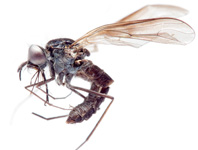Abstract
The shining fungus beetle, Scaphidium amamiense Hoshina & Morimoto, 1999 is synonymized with S. morimotoi Löbl, 1982, based on a review of morphological characters and molecular analysis. This species is endemic to the Amami Islands, the Ryukyus, Japan. An almost completely melanic form (morimotoi in strict) is known only on the island Yoro-shima, where the ordinary form with reddish fasciae on the elytra (previously called amamiense) is absent. The present study suggests that the melanic form on the small island has been fixed by random genetic drift.
References
Abe, Y., Nishimura, T. & Maeto, K. (2013) Causes of polymorphic melanism and its thermoregulatory function in a parasitoid wasp Meteorus pulchricornis (Hymenoptera: Braconidae). European Journal of Entomology, 110 (4), 627–632.
http://dx.doi.org/10.14411/eje.2013.085Fierros-López, H. E. (2005) Revisión del género Scaphidium Olivier, 1790 (Coleoptera: Staphylinidae) de México y Centroamérica. Revision of the genus Scaphidium Olivier, 1790 (Coleoptera: Staphylinidae) from Mexico and Central America. Dugesiana, 12(2), 1–152.
Fukuda, Y., Yamasako, J., Ogawa, R. & Sakai, M. (2015) Review of the Japanese species of the genus Cicindela (Sophiodela) (Coleoptera, Carabidae, Cicindelinae) based on the characters of internal sac. Elytra, New Series, 5 (2), 269–280.
Gibert, J.M., Peronnet, F. & Schlötterer, C. (2007) Phenotypic plasticity in Drosophila pigmentation caused by temperature sensitivity of a chromatin regulator network. PLoS Genetics, 3 (2), e30.
http://dx.doi.org/10.1371/journal.pgen.0030030Guo, H.S., Shen, Q.D., Fang, D., Zhu, J., Fang, Y.H., Wang, B., Meng, Z.J., Wang, S.G., Zhang, F. & Tang, B. (2014) The mtCOI and 16S rRNA variations in colour morphs of Harmonia axyridis Pallas (Coleoptera: Coccinellidae). Oriental Insects, 48 (3–4), 175–186.
http://dx.doi.org/10.1080/00305316.2015.1005959Hazel, W.N. (2002) The environmental and genetic control of seasonal polyphenism in larval color and its adaptive significance in a swallowtail butterfly. Evolution, 56, 342–348.
http://dx.doi.org/10.1111/j.0014-3820.2002.tb01344.xHoshina, H. & Morimoto, K. (1999) Descriptions of three new species of the genus Scaphidium (Coleoptera, Staphylinidae, Scaphidiinae) from the Ryukyus, Japan. Japanese Journal of Systematic Entomology, 5, 87–95.
Hoshina, H. (2006) Review on the genus Scaphidium (Coleoptera: Staphylinidae) from the Ryukyus, Japan. Coleopterists’ News, 155, 11–15. [in Japanese with English title]
Ito, M., Watanabe, K. & Maeto, K. (2015) Molecular evidence resolving the confusion of two species of Spilopteron (Hymenoptera: Ichneumonidae) caused by marked geographical colour variation. European Journal of Entomology, 112 (3), 543–556.
http://dx.doi.org/10.14411/eje.2015.068Leschen, R.A.B. (1994) Ecological and behavioral correlates among mycophagous Coleoptera. Folia Entomologica Mexicana, 92, 9–19.
Löbl, I. (1982) Über die Scaphididae (Coleoptera) der japanischen Ryukyu-Inseln. Mitteilungen der Schweizerischen Entomologischen Gesellschaft, 55, 101–105.
Löbl, I. (1997) Catalogue of the Scaphidiinae (Coleoptera: Staphylinidae). Museum d’histoire naturelle, Geneve, 190 pp.
Masel, J. (2011) Genetic drift. Current Biology, 21 (20), R837–R838.
http://dx.doi.org/10.1016/j.cub.2011.08.007Mikkola, K. & Albrecht, A. (1988) The melanism of Adalia bipunctata around the Gulf of Finland as an industrial phenomenon (Coleoptera, Coccinellidae). Annales Zoologici Fennici, 25, 177–185.
Machado, V., Araujo, A.M., Serrano, J. & Galián, J. (2004) Phylogenetic relationships and the evolution of mimicry in the Chauliognathus yellow-black species complex (Coleoptera: Cantharidae) inferred from mitochondrial COI sequences. Genetics and Molecular Biology, 27 (1), 55–60.
http://dx.doi.org/10.1590/S1415-47572004000100010Miwa, Y. & Mitono, T. (1943). Scaphidiidae of Japan and Formosa. Transactions of the natural history society of Formosa, 33, 512–555.
Morimoto, K. (1985) Scaphidiidae. In: Uéno, S-I., Kurosawa, Y. & Satô, M. (Eds.), The Coleoptera of Japan in color. Vol. 2. Hoikusha, Osaka, pp. 252–258. [in Japanese with English title]
Nakane, T. (1963) Scaphidiidae. In: Nakane, T., Ohbayashi, K., Nomura, S. & Kurosawa, Y. (Eds.), Iconographia Insectorum Japonicorum Colore Naturali Edita. Vol. II. Hokuryûkan, Tokyo, pp. 78–80. [in Japanese with English title]
Nylander, J. A. A. (2004) MrModeltest v2. Program distributed by the author. Evolutionary Biology, Centre, Uppsala University: 1–2. Available form: https://www.abc.se/~nylander/mrmodeltest2/mrmodeltest2.html (accessed 30 December 2014)
Ogawa, R. & Löbl, I. (2013) A revision of the genus Baeocera in Japan, with a new genus of the tribe Scaphisomatini (Coleoptera, Staphylinidae, Scaphidiinae). Zootaxa, 3652 (3), 301–326.
http://dx.doi.org/10.11646/zootaxa.3652.3.1Price, B.W., Henry, C.S., Hall, A.C., Mochizuki, A., Duelli, P. & Brooks, S.J. (2015) Singing from the Grave: DNA from a 180 Year Old Type Specimen Confirms the Identity of Chrysoperla carnea (Stephens). PLoS ONE, 10 (4), e0121127. http://dx.doi.org/10.1371/journal.pone.0121127
Shibata, Y., Maruyama, M., Hoshina, H., Kishimoto, K., Naomi, S.-I., Nomura, S., Puthz, V., Shimada, T., Watanabe, Y. & Yamamoto, S. (2013) Catalogue of Japanese Staphylinidae (Insecta: Coleoptera). Bulletin of the Kyushu University Museum, 11, 69–218. [in Japanese with English title]
Shirôzu, T. & Morimoto, K. (1963) A contribution towards the knowledge of the genus Scaphidium Olivier of Japan (Coleoptera, Scaphidiidae). Sieboldia, 3, 55–90.
Simon, C., Frati, F., Beckenbach, A., Crespi, B., Liu, H. & Flook, P. (1994) Evolution, weighting, and phylogenetic utility of mitochondrial gene sequences and a compilation of conserved polymerase chain reaction primers. Annals of the Entomological Society of America, 87 (6), 651–701.
http://dx.doi.org/10.1093/aesa/87.6.651Silvestro, D. & Michalak, I. (2012) raxmlGUI: a graphical front-end for RAxML. Organisms Diversity & Evolution, 12 (4), 335–337.
http://dx.doi.org/10.1007/s13127-011-0056-0Swofford, D.L. (1991) PAUP: Phylogenetic Analysis Using Parsimony, Version 3.1 Computer program distributed by the Illinois Natural History Survey, Champaign, Illinois. Available form: http://paup.csit.fsu.edu/downl.html#Anchor-58521 (accessed 30 December 2014)
Tamura, K., Stecher, G., Peterson, D., Filipski, A. & Kumar, S. (2013) MEGA6: molecular evolutionary genetics analysis version 6.0. Molecular Biology and Evolution, 30 (12), 2725–2729.
http://dx.doi.org/10.1093/molbev/mst197Tang, L., Li, L.Z. & He, W.J. (2014) The genus Scaphidium Olivier in East China (Coleoptera, Staphylinidae, Scaphidiinae). ZooKeys, 403, 47–96.
http://dx.doi.org/10.3897/zookeys.403.7220True, J.R. (2003) Insect melanism: the molecules matter. Trends in Ecology & Evolution, 18 (12), 640–647.
http://dx.doi.org/10.1016/j.tree.2003.09.006Yamasako, J., Hasegawa, M. & Ohbayashi, N. (2012) Description of a new species of the genus Yimnashana (Coleoptera: Cerambycidae) from Laos. Acta Entomologica Musei Nationalis Pragae, 52 (1), 229–235.

